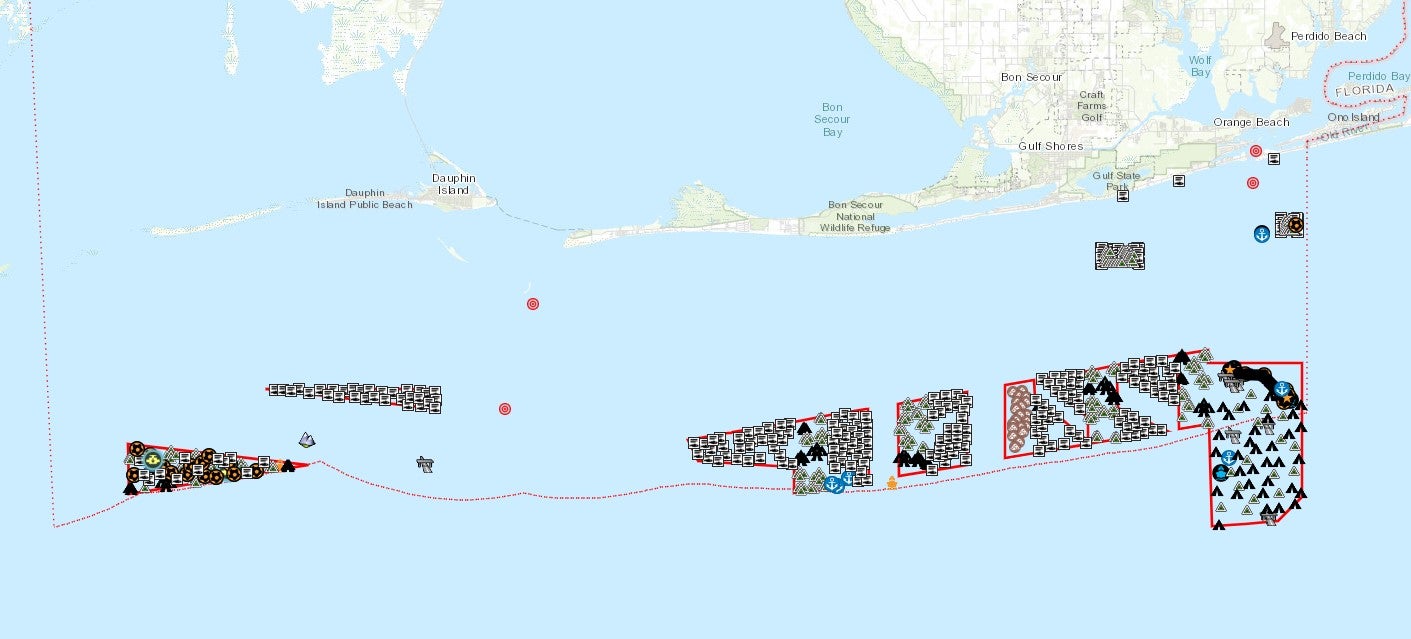The interactive map contains information you may find helpful to plan your Alabama nearshore fishing trips. The interactive map displays all of Alabama’s reefs between 0 and 9 nm offshore, provides a table that details the year each reef was initially constructed and the type(s) of materials used to construct each reef. Click here or on the image to use the interactive nearshore reef map.
Nearshore Reef Coordinates (Current as of September 1, 2023) – To properly download files, right-click the link and select “Save”
The Alabama Marine Resources Division (AMRD) creates hard bottom habitat within 9 miles of Alabama’s coastline to increase the ecological production potential of water bottoms. Hard bottom substrate is very limited along the water bottoms offshore of Alabama and the addition of purposely designed artificial reefs along this predominantly featureless landscape of sand and muddy substrates has proven to be extremely effective at increasing the biomass of reef fish populations including red snapper, gray triggerfish, and gray snapper. Furthermore, constructing high quality reefs within nearshore waters increases the connectivity between inshore and offshore habitats. For example, red drum, sheepshead, gray snapper, and southern/gulf flounder utilize inshore and nearshore habitats. Red drum and gray snapper migrate from Alabama’s coastal rivers, bayous, and bays as juveniles and early adults to the nearshore sand bars, gas platforms, and artificial reefs as spawning adults. On the other hand, sheepshead and flounder migrate to and from inshore waters and nearshore hard bottom habitats each year during spawning migrations. Reef construction projects within this region also increases habitat utilization opportunities of juvenile triggerfish and red snapper before migrating further offshore to inhabit reefs in deeper water with more vertical complexity. Therefore, increasing the availability of a limited resource (eg. hard bottom habitat) will increase foraging opportunities, shelter, and spawning potential of numerous fish.
Not only do these nearshore reefs have an enormous habitat value, they also provide fishing and S.C.U.B.A. diving opportunities for outdoor enthusiasts. Families, including those with young children and the elderly, and anglers with relatively small vessels can easily access many of the nearshore reefs during a short fishing trip. Similarly, reefs in close proximity to shore provide angling opportunities during inclement weather. Other anglers can use the nearshore reefs as areas to catch bait while on their way offshore, or even an opportunity to patrol for cobia during the Spring.
Historically, the majority of nearshore reef construction projects have been focused offshore of Baldwin County rather than Mobile County due to the areas off Baldwin County having fewer oil/gas pipelines, less dynamic sediments, and less multipurpose water bottoms (i.e. dredge spoil areas and shrimping grounds) compared to areas off Mobile County. A number of gas platforms and a handful of artificial and natural reefs are easily accessible for Mobile County anglers within 9nm from shore. DI Bridge 07 and 08, Buffalo Barges I and II, Lipscomb Tug, and Southwest Rock are all within 9 miles from shore. The reefs within 9 nm from Baldwin County’s shoreline are highlighted by the Allen Liberty Ship, the 240+ structures that comprise the ‘Trolling Corridor’, and the 138 reef sites within the R.V. Minton East and West Nearshore Reef Zones.
The ADCNR/MRD recognizes the need for additional reef construction projects within 9 miles of Alabama’s coast and continues to work toward that goal. Not only would additional reefs in this region provide ecosystem level benefits they would also increase fishing opportunities and provide additional economic benefits to Alabama’s coastal communities. Therefore, the next major reef project (pending authorization by United States Army Corps of Engineers) will be creation of approximately 30 mi2 of new reef zones between 6 and 9 nm offshore of Mobile and Baldwin Counties and deployment of over 100 additional artificial reefs.






